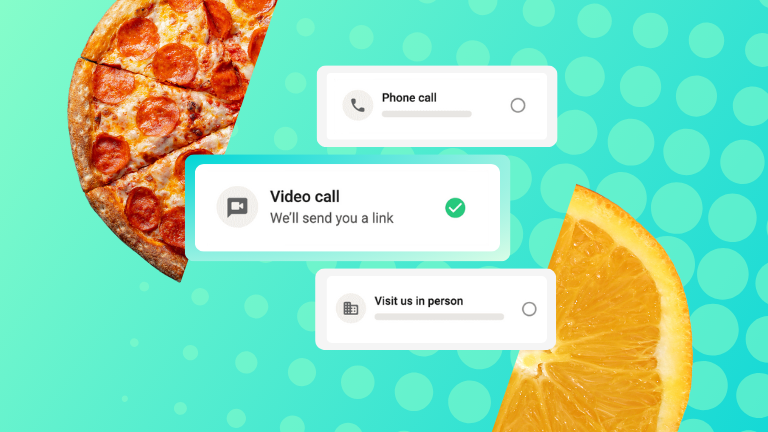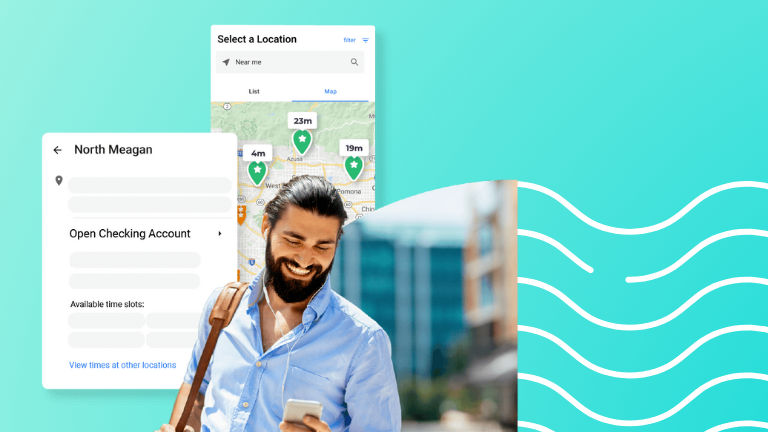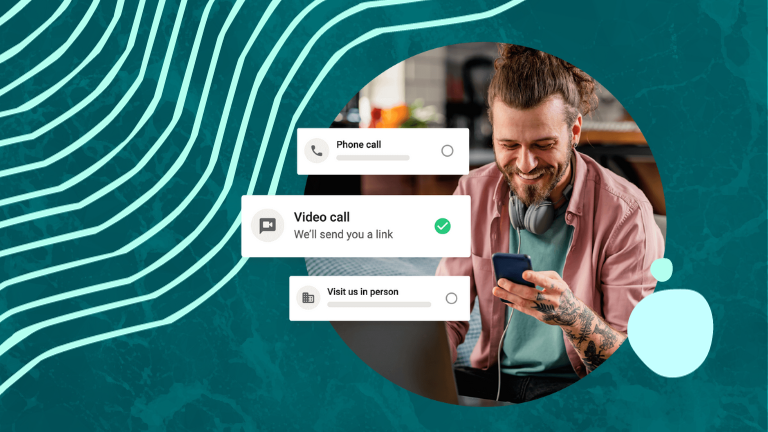Customer Experience in Banking: Top Trends to Drive Growth

There are seemingly infinite strategies for financial institutions to drive growth in the modern age of banking. For example, a better marketing strategy, a wider range of financial products, and a more streamlined approach to staff scheduling can all go a long way to helping a bank or credit union grow.
But if you’re looking for the single most impactful way to drive growth in banking, it’s time to prioritize the customer experience. According to a recent survey of 1,700 consumers, 92% say quality customer service is the most important factor when determining where to open a bank account. Another 63% of consumers say they’re not likely to switch away from a bank that offers great customer service, and 78% say they’ll return for similar services.
It’s hard to overemphasize the importance of customer experience in banking. Financial institutions that optimize customer experience grow faster, have higher NPS scores, and have better retention rates than banks that don’t put the same emphasis on customer experience.
So how can your bank or credit union provide the absolute best banking experience to your customers and members? And what does customer experience in banking mean, exactly?
In this post, we’re exploring how to improve customer experience in banking. We’re also delivering the top customer experience trends to drive growth and help you beat out the competition.
What Is Customer Experience in Banking?
So what is banking customer experience? Ultimately, it’s the way members and customers feel about your financial institution. No matter how much effort you’re putting into the customer experience, it all comes down to your client’s perception. If your clients don’t have a great opinion of you, then you’ve missed the mark and won’t see the growth you’re seeking.
Customer experience encompasses every interaction a client has with your financial institution, from simple daily activities to one-on-one meetings. Each one of these interactions has an impact on their opinion about your bank or credit union.
Some of the most common customer experience touchpoints include:
- Paying a bill online
- Using an ATM
- Withdrawing money
- Meeting with an advisor
- Opening a bank account
- Visiting an FIs website
- Standing in line at a branch
- Meeting via video conferencing
- Talking to an advisor over the phone
All of these touchpoints matter. If customers and members repeatedly have positive interactions with your bank or credit union, they’ll develop loyalty to your institution and continue to be a customer. If they have ongoing negative interactions with your institution, they’ll develop a poor perception of your bank or credit union, and find another institution to bank with.
What Makes the Best Banking Experience?
So what makes a great banking experience? And how can a bank’s customer experience be improved? Is AI taking over banking technology?
For concrete answers, let’s turn to the data. We’ve studied many customer experience reports to reveal one common thread: it’s all about keeping things simple.
That’s right. Sometimes, less is more, and adding more services and more technology isn’t necessarily going to improve a customer’s perception of your financial institution. You’ve probably experienced this phenomenon yourself — if a brand changes its offerings or requires you to use complicated technology to maintain your services, you may just find yourself frustrated and ready to ditch the brand altogether.
On the other hand, an organization that provides simple, intuitive customer experiences is more likely to keep you around for the long run.
So how can you keep it simple, while still improving the customer experience in banking? Let’s walk through some of the key trends and examples.
Streamline Your Branch Experience
One of the first steps to building a better customer experience is to streamline your branch experience.
To accomplish this, it’s important to look at both the little things (How are customers greeted when they come in? Where do they get in line? Do they know how long the line will be?) and the bigger picture (Do you offer a fast lane? Are your advisors efficient and friendly?)
Here are four ways to streamline the customer experience at your bank or credit union:
1. Make Your Branch Feel More Welcoming
Your customers and members come to your branch because they have a need. Maybe they’re opening a new account, applying for a mortgage, or simply coming to withdraw cash. In any case, it’s in your best interest to make the experience as welcoming as possible. All the little details matter here, down to the lighting and the temperature in the room.
Even if it’s in their subconscious, customers will note how they feel when they’re in your branch. If they feel comfortable, calm, and welcomed, they’ll be more likely to return. And if they feel uneasy, irritated, or unwelcomed, they’ll be quick to move to another bank that offers a better in-branch experience.
You can make your branch feel more welcoming by allowing clients to sign in on their own via a tablet kiosk, providing wait times, and making physical changes, such as:
- Adding ambient lighting
- Shifting the floor transitions
- Installing colored carpeting to guide visitors
- Removing stanchions
- Removing bulletproof glass
- Removing the counter altogether
- Adding “flex desks” and call booths
All of these simple changes can go a long way to make the branch more comfortable for your customers and members.
2. Allow Your Clients to Book Their Own Appointments
When you want to improve the customer experience, you need to put your clients in the driver’s seat more often. Modern banking customers crave the freedom to choose their own path. They want flexible, self-service options — and client booking tools give them just that.
A bank by appointment platform makes it easy for customers and members to book their own appointments, plan ahead, and be seen right away when they arrive.
Here are just a few of the many benefits you’ll experience when you leverage banking appointment software:
- Save time. Allowing customers to book their own appointments saves them time, lets them plan ahead, and ensures they’re seen right away when they arrive.
- Reduce no-shows. Appointment reminder emails help customers keep track of their schedule, remember their appointment, and come prepared with the right documents.
- Increase efficiency. Appointment software also helps staff be more prepared, meaning appointments are shorter and more efficient.
- Reduce wait times. Customers don’t like waiting, and appointment scheduling software can help by keeping wait times to a minimum.
3. Create a Fast Lane for Simple Services
Not every customer or member needs the same level of service when they come into the branch. Some might need to order a new checkbook or submit a credit card application, while others will need to have an extended meeting with an advisor.
But people who need those quick services shouldn’t be forced to wait in lengthy lines. Instead, you can improve the customer experience — and reduce wait times for everyone — by offering a fast lane for simple, quick services that won’t take more than a few minutes to complete.
4. Offer Curbside and Home Delivery Banking
Banks with the highest customer satisfaction rates tend to deliver services wherever their customers and members already are. Rather than requiring every customer to come into your branch, make it easy on them by offering curbside and home delivery banking.
Here’s how it works:
- Curbside banking. Post a QR code on your front door for quick services, or send associates out to meet people at their car window. For many financial institutions, this option is more convenient than drive-through banking.
- Mobile banking trucks. Drive growth and brand awareness by taking your mobile banking truck to festivals and events. Your banking truck can provide services like ATMs, new member signups, and more.
- Cash pick-up and delivery. Hire couriers to provide customers with secure deposit pick-ups and withdrawal delivery.
Connect Online and Offline Services
Today’s banks must provide customers and members with the best of both worlds: the ease and convenience of online banking, and the reliability of tried-and-true, in-person banking. But it’s important to make these two experiences cohesive — which can be no small feat.
Let’s take a look at the ways banks are optimizing the customer experience in banking through a cohesive, hybrid approach:
1. Give Clients Choices
Your customers want to decide for themselves when and where they interact with your bank. And since no two customers are alike, it’s vital to provide lots of options. A stay-at-home parent of young children may appreciate the ease of video banking, while an older customer might rather visit in person, as they always have.
Here are some hybrid banking services that help improve the customer experience by increasing customer choices:
- Appointment scheduling
- Queue management
- Video banking
- Online chat tools
- In-branch services
- Virtual queues
- Digital check-ins
- In-branch fast lanes
- Self-service queues
By giving your customers and members more flexibility in the customer experience, you’re sure to boost satisfaction and loyalty.
2. Unite Each Channel
Omnichannel communication is the gold standard for today’s top brands — and the same standard holds for financial institutions. Customers expect a united, cohesive experience as they toggle between in-person and online services.
Your clients shouldn’t have to repeat details over and over again. Instead, their data should be stored in a central, secure spot so staff has quick access — no matter how they’re communicating with a customer.
Banks and credit unions can offer a unified and personalized touch by creating customer profiles. These profiles should include a full history, including past interactions, conversations, services, and more. Staff members can use this profile to tailor conversations with the customer and deliver a better, more personalized, and more streamlined banking experience.
3. Leverage Biometric Authentication
Cybersecurity is more important than ever before. But customers also don’t want to hassle with remembering passwords and security questions before every login. So what’s the solution? Biometric authentication.
Tools like voice recognition, fingerprinting, and eye scanning offer a high level of security that decreases fraud and saves time. In fact, when Connexus Credit Unit adopted biometric authentication in its call center, it reduced authentication time from 90 seconds to 12.5 seconds.
Provide the Right Mix of Services
Is your financial institution a one-stop solution for all of your customers’ banking needs? If not, it’s time to reevaluate the services you offer. If you really want to optimize your customer experience and drive growth, you need to provide all of the banking services your customers and members expect. Otherwise, they’ll be forced to bank with several different institutions, decreasing their loyalty and overall satisfaction.
1. Provide Quality Support and Service
When you’re mixing in-person and online services, it’s easy for the quality of support to slip. But the best banks are able to adopt a hybrid approach that elevates the customer experience across the board.
Here are three signs you’re providing quality support and service across in-branch and online services:
- Ease of use: Customers have quick and easy access to information, resources, and staff.
- Quick routing: Customers and members are quickly routed to the right place and have the flexibility to chat, call, or visit a branch in person. A combination of services is available during typical business hours and outside of normal hours.
- Flexibility: If customers need to cancel or reschedule an appointment, they can easily do so using self-service tools. Likewise, if they want to switch from chat to a phone call, or from in-person service to video banking, they have the option to do so.
Equipped with these features, you’ll have a key competitive advantage that allows you to retain existing customers and bring new customers to your financial institution.
2. Create a Peer-to-Peer Strategy
The use of payment apps like Square, Venmo, and Zelle are on the rise. In fact, one in three Americans use peer-to-peer banking apps to quickly and easily pay each other, and the industry has grown by 13% since the COVID-19 pandemic.
Since clients are used to moving money freely — without any fees or delays — they expect banks and credit unions to offer the same service. You can deliver the same effortless banking experience by partnering with one of the major peer-to-peer players, (like Wells Fargo x Zelle), or by building your own tool, as Goldenwest has done. Banks that adopt a peer-to-peer strategy will be ahead of the traditional banking industry and well-positioned to retain customers for the long haul.
3. Utilize Video Banking
The pandemic forced video banking into the spotlight out of pure necessity, but this convenient, flexible form of banking isn’t going anywhere. In 2020, 46% of consumers said they’d continue using video appointments to speak to their financial advisors, even after branches reopened to the public. Similarly, 85% of video banking customers say they’d use it again.
The benefits of video banking are clear. This channel provides the same ease of communication and relationship-building benefits as in-person services while saving the client on commute time, and eliminating the need to wait in line.
Here are some of the most common use cases for video banking:
- Set up accounts and help new members
- Go over contracts before signing
- Provide product information
- Troubleshoot client questions
- Get a pulse on financial health
- Give a virtual seminar
Video banking isn’t just great for customers — it benefits staff and administration, too. Since the staff can join a video banking call from anywhere with co-browsing, they can be more efficient and productive with their time. Paperwork can be completed during the video appointment, and this tool allows banks to easily open branches in new regions.
4. Increase Efficiency of Advisory Services
Do your customers and members understand the full breadth and depth of the advisory services you offer? Can they easily book services online and in person? If not, it’s time to up your marketing game and improve the efficiency of advisory services.
When customers don’t know what you offer, they won’t be able to take advantage of the services they need, and your financial institution won’t be able to grow.
You can easily increase efficiency by offering digital booking services. Online booking platforms make it easy to bring in new customers, capture market gaps, and deliver a more personalized banking experience. It can also reduce phone cues and improve consistency across the customer experience.
Communicate Clearly
Clear communication has always been a critical part of the customer experience in banking. But as financial institutions add multiple channels, it becomes even more paramount.
Whether customers are interacting with your institution through your app, chat, in-person, or by mail, it’s important to make sure the customer understands exactly how you can help meet their needs.
Here are three ways you can improve communication across all channels, leading to increased customer retention.
1. Simplify Customer Journeys
When it comes to the customer journey, the best rule of thumb is to simplify, simplify, simplify. Customers will always take the path of least resistance, so if you make it easy for them to bank with you, they’ll be more likely to stick around.
To identify areas for improvement, start by creating a diagram or chart of all communication channels and who received them. Then analyze each channel to decide if these customers are actually getting what they need.
Here are some of the best ways to clarify your communication:
- Optimize emails with brief, professional copy and design
- Write direct, short in-app copy
- Create clear and catchy calls to action across all channels
- Optimize your website to make it accessible to all customer needs
- Redesign statements to guide the viewer’s eyes and provide value
- Educate staff on best practices for promoting new products and services in person
- Use A/B testing to optimize ads and website design
2. Implement a “Next Best Action” Tool
Sometimes customers and members need a little nudge to take them in the right direction. Or maybe they purchase a product from your bank and don’t even realize the other ways you could help meet their financial needs. This is where a “Next Best Action” tool comes into play.
A “Next Best Action” tool is an AI integration that helps both customers and members and financial institutions by suggesting ideas for additional services customers may want or need. AI tools can even recommend relevant products to help drive growth across the existing customer base. In the end, customers and members walk away more satisfied, while banks and credit unions drive growth.
3. Offer Financial Literacy Tools
In the midst of economic uncertainty, today’s consumers want expert help managing their money. In fact, a recent survey revealed that 66% of consumers are seeking proactive, personalized advice from their FI in order to relieve their financial burdens.
Of course, a bank or credit union is the natural place to turn to for help with money management. Yet many financial institutions lack the financial literacy tools their members and customers crave.
One of the best ways to improve communication and drive growth is by expanding educational offerings, including:
- Blog posts
- Articles
- Podcasts
- One-on-one mentoring sessions
- Group workshops
- Financial coaching
- And more
As you develop your own financial education program, make sure you take a personalized approach. Hire trained financial educators who understand your customers’ needs, concerns, and goals. The more you invest in the program, the more you’ll improve the customer experience and show your customers that your priorities are in alignment.
Conclusion
Improving the customer experience in banking simply can’t be ignored. Banks and credit unions must provide a best-in-class experience to keep their customers and members happy.
The best way to do this is by putting the customer in the driver’s seat. Give them freedom, flexibility, and choice so they can interact with you however they please. This means multiple communication channels, 24/7 accessibility, in-person and online services, self-service options, and more.
If you’re ready to put your customers and members at the helm of their banking or credit union experience, Coconut Software can help. Get in touch today to schedule a demo and see how we can help you improve the customer experience in banking to drive growth.





